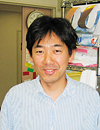It is widely accepted that the genetic information contained in organisms is encoded in nucleic acids. However, with the prion group of diseases, proteins are thought to contain the causative genetic material. “Prion diseases” refers to a group of neurodegenerative diseases that are potentially fatal in a wide range of animals. They include bovine spongeform encephalopathy (BSE, or mad cow disease) and Creutzfeldt-Jakob disease (CJD) in humans. Recently, the occurrence of CJD caused by humans eating beef from prion-infected cattle with BSE has made a significant social impact.
The prion diseases are composed of various forms, including a spontaneous hereditary form, and an infectious form. The “prion hypothesis,” claiming that the prion protein is the causative substance of prion diseases, has been a subject of continued discussion since Dr. Prusiner won the Nobel Prize in 1997 for his research in this area. Recent studies have demonstrated almost conclusively that the infection source is an aggregation of abnormally folded prion proteins. The theory claims that the prion protein aggregate functions as a suitable medium for supporting the conversion of normal soluble prion proteins into aggregates that may eventually cause cytopathy.
However, the prion phenomenon still poses a significant number of problems. Even today, we hardly know anything about the “shape” of the prion aggregates that are infectious, or the molecular mechanism involved in the propagation of infection. Furthermore, we know very little about the factors that determine the shape of prion aggregates, and how cross-species prion infections occur. Our research unit is tackling the basic issues associated with the prion phenomenon using yeast. It goes without saying that prion diseases are observed only in mammals and that they do not occur in yeast. However, yeast is suitable for our research program for the following reasons.
Yeast, a unicellular organism measuring about 5µm in its long axis, has been used as a model organism in eukaryotic cell research for many years. Although it does not appear to have much in common with humans, surprisingly it does exhibit basic molecular mechanisms of the complex life forms. In fact, yeast is an excellent research material for the study of prion behavior: although the prion protein of yeast has a different amino-acid sequence from that of mammals, the behavior of these two kinds of prion proteins is very similar. In addition, yeast has a very high reproduction rate and this characteristic makes it possible to observe the prion phenomena in a shortened timeframe. For these reasons, research into yeast prions has become very important for supporting prion research in mammals.
As past experience has indicated, research into the mechanisms of aggregation and propagation of prion protein has also provided a significant contribution to the advancement of research into other neurodegenerative diseases involving atypical folding of protein. We hope that in the future our elucidation of unsolved prion phenomena at the molecular level will lead to further advancements in the study of neurodegenerative disease as well as supporting the development of effective new curative drugs for prion and similar diseases. In addition, we sense that the prion phenomenon is giving us a glimpse of the phenomenon of cytoplasmatic inheritance of living organisms in which nucleic acids do not act as an intermediary. If this is so, there is the possibility that cytoplasmatic inheritance factors other than the prion may also exist and that these may also be involved in the maintenance of life activities, rather than being merely the causative agent of diseases. The study of “prion biology” does not always stay within the framework of traditional prion research. It may provide us with clues to uncover as yet unknown phenomena of living organisms.






